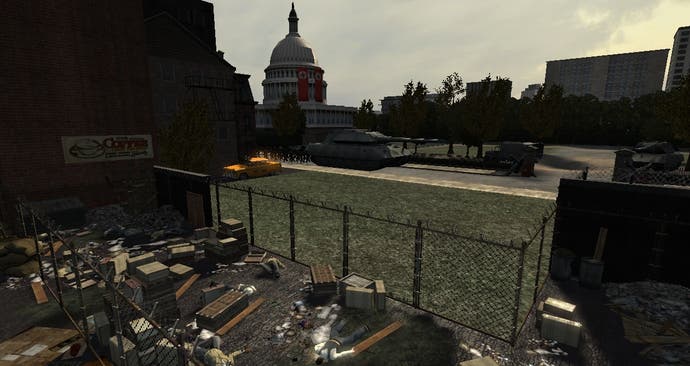Turning Point: Fall of Liberty
The Nazis invade America.
It is, as Allen points out, unflinching in its depiction of violence. During his introduction, he explicitly links the conception of the game to 9/11. Which is interesting because there are other moments of resonance during the various movies and demos: planes crash into skyscrapers, rendering them towering infernos; bodies fall from the rooftops; kneeling prisoners are executed with a bullet to the head. It's interesting because it's clearly a manifestation of the American fear of invasion (which has ironically spawned several American invasions of other countries). It's also interesting because, of course, ratings boards on both sides of the Atlantic have shown a recent tendency to clamp down on the depiction of violence in games.
But Allen is confident that such an unflinching approach is justified: "We're not doing things in a gratuitous fashion. If we have any scenes that are shocking it's because they are a reflection of the reality we're trying to portray, and we're basing that on real or probable events. When we do have violence and mature moments in the game, they're serving the theme, and the theme is that this war is personal. And war is a brutal thing. We're not trying to romanticise it or to glorify it: if it's shocking it's because it should be."
In any case, there's more to the game than violence. There are also jet aircraft and massive zeppelins overhead - a facet of the advanced Nazi technology that is one of the game's key features. Like the counterfactual scenario, all of the technology is plausible and based on the research breakthroughs that the Nazis had made by the end of the real World War II. Technology like infra-red goggles, for example, or the attack blimps all stem from real-world discoveries. And in the second demonstration of the day, the blimps play a big part, as Carson dodges their searchlights, rappels along ledges, shoots people in the chest and takes out an entrenched machine-gun position in what Allen describes as one of the game's quieter levels. It's still very loud.

As is the final showreel, which sums up the cinematic polish and the atmospheric sense of an occupied America by showing off another of the game's key features: real-world monuments (largely getting blown up). As the action spans across New York, Washington and London, Nazi gunboats proceed down the Thames under Tower Bridge; The remains of the Chrysler Building provide a dramatic backdrop for another shootout; and finally, the White House explodes, offering a hint of the dramatic twists and variety that Allen reckons will characterise the narrative.
"Good entertainment has something to say or to invite discussion on," he argues. "What we would hope is that Turning Point offers a number of interesting themes that hopefully invite discussion. One of those is about people being the product of the decisions they make in life. On a global scale, decisions by political leaders lead to global changes, so we're really trying to have a game that explores those sorts of ideas."
